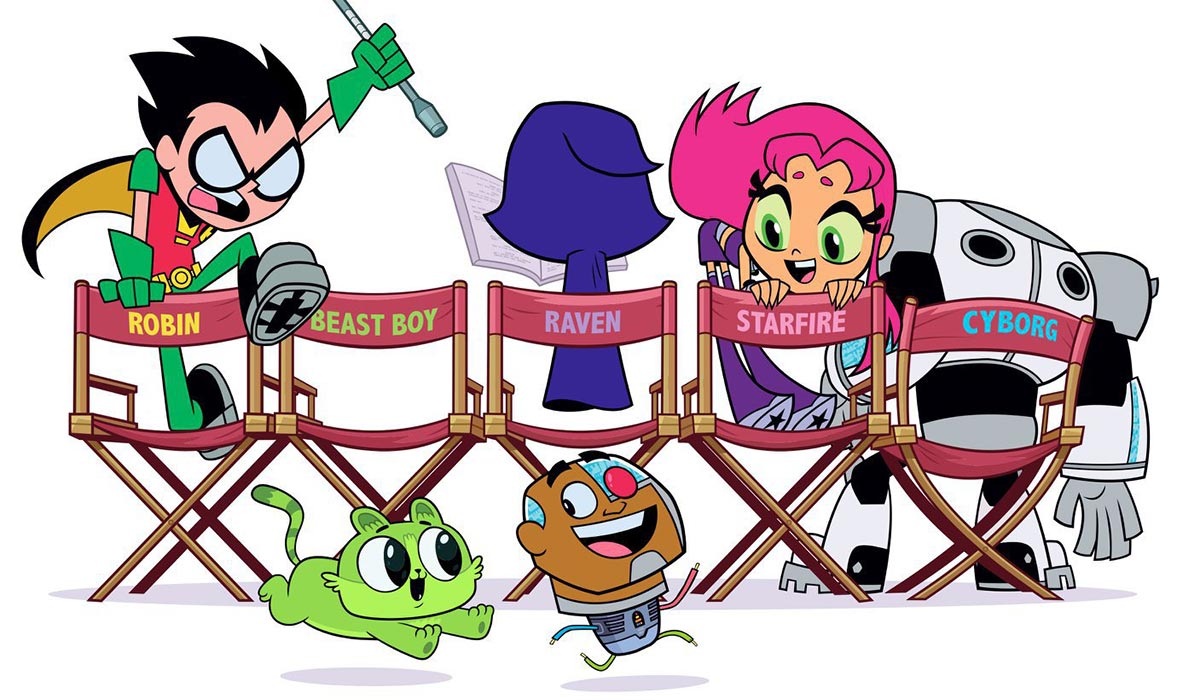Warner Bros. (2003), Warner Home Video (February 7, 2006), 2 discs, 286 mins plus supplements, 1.33:1 original full frame ratio, Dolby Digital 2.0 Stereo, Rated TV-Y7, Retail: $19.98
Storyboard:
Five teenaged superheroes juggle videogames, personal disputes, and saving the world.
The Sweatbox Review:
They fight for truth, justice, and the last piece of pizza…! They’re the Teen Titans, stars of one of the hottest cartoons of the early 21st century. Kids love it, but does it live up to the standards set by previous shows, not to mention its own source material?
Please bear with me. I need to give you a little history lesson first…
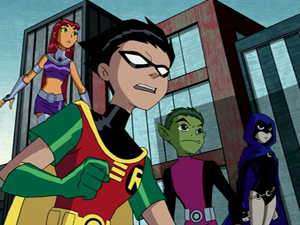
Back in 1980, DC Comics was known for having the best-known superheroes in the world, but some of the stalest stories on the comic racks. Everyone knew who Superman and Wonder Woman were, but their adventures seemed old-school, quaint, and boring to those that preferred the angst and drama to be found in the comics published by Marvel, such as those featuring the X-Men, Spider-Man, and the Hulk. DC had tried to catch fans’ attention with their brief attempt at publishing unique characters by Jack Kirby and Steve Ditko in the 1970s, but flooding the market with bizarre new titles was not the way to go. DC’s future success would be found in reviving old characters and concepts, a process that was truly catalyzed by the universe re-creating miniseries Crisis On Infinite Earths in 1985, but it had its seeds in a little 1980 comic called The New Teen Titans.
The original Teen Titans from the 1960s had consisted entirely of adolescent sidekicks to DC’s major heroes, with an initially unnamed group of three boys soon being joined by a female member. The original roster starred Batman’s partner Robin the Boy Wonder, Aquaman’s little buddy Aqualad, the Flashs’s nephew Kid Flash, and— in the first “official” Titans story— Wonder Woman’s kid sister Wonder Girl. Green Arrow’s partner Speedy joined in a while, followed later by a number of new and old teen heroes. The series had a couple of runs in the psychedelic 1960s and the groovy 1970s before petering out… and then writer Marv Wolfman and artist George Perez came up with their new Titans group.
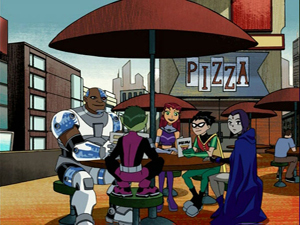
The 1980 version brought back Robin, Kid Flash, and Wonder Girl, and added the previously seen Changeling (formerly Beast Boy of the Doom Patrol), and three brand-new heroes: the part-machine Cyborg, mystical Raven, and the alien princess Starfire. The first few issues showed promise, with some clunky storytelling being overcome by cool concepts such as Titans Tower, an intriguing mystery behind the team’s formation, and superb art. Things started to pick up in issue #8 when the story A Day In The Lives appeared. That story featured no superheroics— just the Titans in their civilian identities experiencing life. The most poignant moment came when Cyborg, in the midst of feeling sorry for himself in the face of what he perceived as lost humanity, encountered a group of kids with prosthetics. Rather than being frightened of Cyborg’s robotic appearance, they thought he had the coolest “parts”. It was stories like these that came to define The New Teen Titans; it was a comic that mixed good old-fashioned superhero stories with humanistic depictions of the characters as real people who just happened to go out and fight crime while wearing spandex (or in Starfire’s case, tiny strips of strategically-placed armor). Soon, The New Teen Titans became DC’s best-selling title, giving the publisher a much-needed boost and new credibility. The next few years featured many wonderful tales of love, betrayal, pathos, humor, and of course whiz-bang action.
I give this background to place into context the Teen Titans cartoon. Conceived as an obvious attempt to cash in on the popularity of the Batman, Superman, and Justice League programs over the past few years, the Titans cartoon debuted in August 2003. It ditched all the sidekick characters except for Robin, probably a necessary streamlining in order to keep the show from looking too much like “Junior Justice League”. It did, however, keep the other characters from the 1980 comic reboot (with Changeling reverting to his original “Beast Boy” name). On the surface, this would seem to be an adaptation of The New Teen Titans comic from the 1980s, especially given that the villains from that version of the Titans appear in the cartoon too. Unfortunately, the whole concept of the cartoon stories is radically different from the source material. Rather than focusing on the characters’ civilian identities, the show totally removed them. The kids are always in costume, and initially we do not even know which Robin we are watching— Dick Grayson and Tim Drake were both Robin in the Batman shows, but there’s no hint as to which version we are watching in the early episodes of Teen Titans. And when I said “kids” earlier, I meant “kids”. Rather than the 16 to 19 age variance of the 1980s comics’ characters, the cartoon versions seem to have only quite recently left the age of twelve. Any adult fans who were looking forward to seeing a mature cartoon based on a childhood favorite are bound to be disappointed in what turns out to be a kiddie show.
Now, with my own prejudices revealed, we can look at the show on its own merits. After all, just because it’s not the Teen Titans show I wanted, it doesn’t mean it’s no good, right?
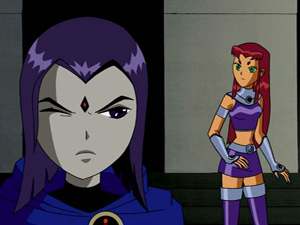
Well, my first impressions were not too great either. The producers, eschewing the Bruce Timm stylings of previous DC shows, went for an “anime” look. Naturally, anime fans may point out that there is a great diversity to anime visuals, so we cannot say that one look is “anime”— but watching one scene in Teen Titans is all you need to see that there is a definite influence from Japanese television cartoons. That’s great if one likes huge face-devouring mouths, long-held takes that are incredibly off model, rushing lines for backgrounds, and cutesy interplay that undermines any dramatic tension; but I do not. Again, I found this disappointing. Sigh. I’m not saying that these are not valid choices for an American cartoon to make, but why did they have to do it to my Titans??!
Obviously, the stories would have to be great in order to win over this skeptical viewer. The DVD first season release includes thirteen episodes of varying tone. There is no doubt that the show holds some entertainment value. The action is brisk, the characters each have distinct (if thin) personalities, and there is a strong sense of fun throughout. On the other hand, the intentional decision to make a show for young kids has yielded some plots of extreme simplicity, with nowhere near the emotional depth of the comic.
At least the character designs are quite good. Robin has been updated slightly to get bigger boots and spikier hair (more anime influence, but this one I did not mind). He is also portrayed as the capable leader he should be, although prone to adolescent outbursts like anyone else. Starfire got the wet hair look, losing the lustrous curls shown in the comics (and she has pupils now, which I know were added since they animate better than empty eyeballs); but otherwise her look is appealing. She is still the pure innocent, but is at first less emotional in the cartoon than the comic, where she was a woman of extreme emotions; here, she often demonstrates a relatively passive personality before becoming more demonstrative as the show progresses. Beast Boy seems younger than the others and is the wisecracker in the group, which is true to the comic, but I still do not know about the fang he grew for the cartoon. My two favorite designs are for Raven and Cyborg, who got some plastic added to the metal in his armor. Raven’s character, though, comes off more snarky than in the comics, where her cool demeanor was a counterpoint to Starfire’s emotional outbursts. Cyborg is presented in the cartoon with the right sense of “urban-ness” showing him to be streetwise but without making him seem like a street punk. It’s fortunate that the costumes look good, since the teens go everywhere in them— out for pizza, to amusement parks, picnicking, everywhere… I suspect they might even sleep in them.

Episodes – Disc One
Divide And Conquer: Standard bad-guy type Cinderblock breaks into jail to rescue a prisoner. The Titans try to prevent the jailbreak, but their inexperience leads to failure and hurt feelings between Cyborg and Robin. We get our first peek at their nemesis Slade, who even the Titans have not yet heard of. (He was known as Deathstroke The Terminator in the comics.) On the way, the kids get a lesson in resolving disputes between friends (in very typical “guy” fashion), and a monster from the comics is introduced.
Sisters: Starfire’s sister Blackfire comes to visit, and quickly insinuates herself with the Titans while making Starfire feel excluded. At the same time, Starfire is being hunted by aliens— could there be a connection? This is a relatively strong episode, which portrays the Titans well as friends and has a nice twist (as if you could not guess it already).

Final Exam: The HIVE is introduced, an organization which has produced three young super-powered youths to work for Slade. Slade uses them to send a message to the Titans, who really get their butts kicked in this episode. Gizmo, Mammoth and Jinx, who formed part of the comics’ Fearsome Five, make their debut. We still get no closer to learning Slade’s real motivation, however.
Forces Of Nature: Thunder and Lightning, also based on foes (at least for most of their first story) from the comic, go on a playful rampage. In the end, Beast Boy gets through to the brothers, who learn a lesson in responsible use of their powers. I really did not understand where the Flame Monster in this episode came from, and would have appreciated a clearer plot in that regard, especially given the appearance of Slade at the end. Slade and mystical elementals just do not seem to mix.
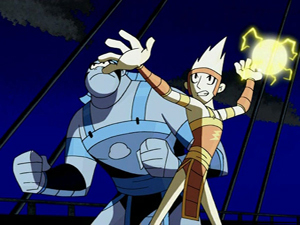
The Sum Of His Parts: This is an enjoyable episode, where Cyborg is first rescued and then endangered by the mysterious Fixit when his power battery fails. We get a better look at what it is like to be Cyborg, which was a welcome relief from the producer’s insistence on not having any real complexity to the characters’ personalities. However, the writers added a moment from the comic story A Day In The Lives (which I referenced earlier) as such a shallow throwaway that I found it almost hurtful. What had been a landmark touching scene in the comic became a useless bit that ends with Cyborg proclaiming “Now I’m going to go kick bad guy butt”. I was just starting to appreciate the show on its own merits, and they had to remind me of how much better the comic was.
Nevermore: This is our peek at Raven’s mind— literally. After Raven goes extra-dark on Doctor Light, Beast Boy and Cyborg approach her room at the Tower and get sucked into her mind via a magic mirror. Raven’s dad is revealed, which likely came as a shock to those unfamiliar to the comic character. Note: The Titans theme is sung in Japanese for the first time in this show’s opening.
(That is where the original, partial-season DVD release for the show ended. On this set, the first disc goes for two more episodes.)
Switched: The Titans receive a mysterious package containing puppet versions of themselves. The Puppet King then shows up to transfer the souls of the Titans into the puppets, so that he can control their real bodies. His plans go awry when Raven partially stops his attack on herself and Starfire, but the two girls end up in the wrong bodies. In order to stop the Puppet King and save the boys, Starfire and Raven must learn to understand each other.
This is a clichéd type of plot in a way, but it works very well here because of the characters the writers chose to switch. Starfire must learn to control her normally passionate emotions in order to prevent Raven’s powers from running amok, while Raven must learn to be less restrained in order to operate in Starfire’s body. By the end of the story, the two girls have gone from being antagonists to friends. There’s a message in there for kids (and adults) about learning to see things from another perspective.
The only problem with the episode, like some of the other Teen Titans shows, is that the villain is not fleshed out or even explained. One gets the idea that the Puppet King is a neat character, but we never learn enough to be sure.
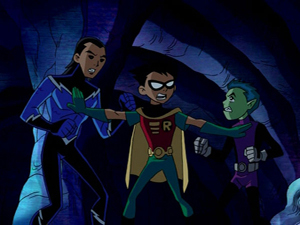
Deep Six: A villain named Trident (Clancy “Lex Luthor” Brown), who does actually get a back-story here, hijacks a ship carrying toxic waste. The Titans take a trip underwater, led by shape-changing Beast Boy. They gain an ally in the form of water-breathing Aqualad (Wil Wheaton), but Beast Boy only sees a rival. This episode emphasizes how Beast Boy is the least mature of the Titans (which is true to the old comics), but he does come along a bit in this story.
Aqualad was visually totally re-imagined for the cartoon show. I don’t mind them losing the curly hair from the comics, but it might have been nice if one could at all tell it was supposed to be Aqualad. What, they could not have made the costume red and blue at least? And shouldn’t Aqualad be swimming in the water? Why does it look like he’s flying? Yeah, I know. No one likes a whiny fanboy. I did like the fact that the girls fell for Aqualad, since the show could use a little more romance to go along with the crime fighting and pizza eating.
This story was written by Marv Wolfman, who wrote a couple of different versions of the Titans in the comics, including the 1980s’ New Teen Titans. And, there’s one more guest star I didn’t mention: Dave Coulier plays the sea captain— Full House fans rejoice!
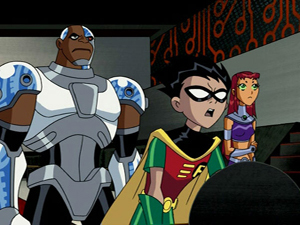
Disc Two
Masks: Robin battles the minions of Slade over a computer chip. After the battle, it can be seen that Robin is growing progressively more infatuated with finding and stopping Slade. At the same time, a new player named Red X comes on the scene to compete for Slade’s attentions. There’s lots of action in this one, as the Titans must contend with an adversary who can best them all.
Detention: The Titans have been kidnapped and are being held in a crazy house. Mad Mod, for reasons unknown (another motive-less villain), wants to punish the Titans for being good guys. Mad Mod is a British nut who reminded me of a more sinister Austin Powers. In actuality, Mad Mod first appeared in the Teen Titans comics way back in 1967, during their campy phase.
Every few episodes, the music on this show kicks it up to the next level, and here we are treated to some groovy 60s’era Brit music, as well as an original song from Puffy Ami Yumi. It adds to the fun of this unique episode, with the pop song playing over a chase scene, Scooby-style, in a sequence that becomes enjoyably surreal.
Mad Mod is played by Malcolm McDowell, which was delicious casting, considering the anarchic role he played in Stanley Kubrick’s A Clockwork Orange.
Car Trouble: Cyborg completes his work on a new vehicle for the Titans. His teammates are impressed and grateful, but they (well, mainly Raven) question whether he loves the car a little too much. Cyborg falls apart when the car is stolen, and he has to find it again. Gizmo shows up, too, and— did he really fart at Cyborg?! Yikes. This episode is okay, but the least likely to get watched again.

The Apprentice Parts 1 and 2: I know you all were thinking that I was going to make a Donald Trump joke here, but I’m not. That would be too obvious and silly. Robin remains determined to capture Slade, and he continues to allow it to affect his behavior. It is finally revealed to him that Slade has been looking for an apprentice, and Robin is forced to join him when his friends are threatened.
Will Robin follow the path of darkness? Will he be able to escape the clutches of Slade? Or, if all else fails, will he be released when he hears, “You’re fired!” (Okay. So I’m obvious and silly.)
There are finally a couple of nods to Batman in this story, where Robin tells Slade he already has a father (followed by a shot of bats), and there is also a fight at a Wayne Enterprises building.
After the relative frivolity of the previous story, this 2-parter intensifies the proceedings nicely and brings Season One to a strong close.
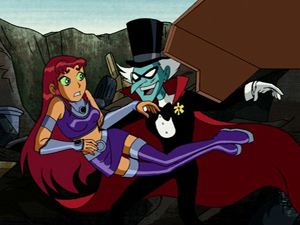
You really have to be in an anime frame of mind to appreciate the look of this show. Producer Glen Murakami and his colleagues purposely infused the show with anime energy, making this show a unique combination of American and Japanese sensibilities. Murakami felt that, being that the animation always gets done in Asia, they might as well try to play to the strengths of the Asian animators, while offering something new to viewers used to the “Timm style”. (This was no snub to Timm, who is also listed as a producer on the show.) The artists use metamorphosis (with characters changing sizes and especially eyeballs, which become quite abstract at times), animated inanimate objects (even Titans Tower can bounce around when called for), and symbolic imagery like characters being portrayed as babies. It’s not my cup of tea, but I do appreciate the effort to do something “new”.
Is This Thing Loaded?
Finding Their Voices (7:51) is a new featurette that gives us on-camera interviews with most of the Titans’ voices (all but Starfire’s), as well as comments from casting director Andrea Romano and other show creators. I love meeting the actors, and wish all cartoon DVDs would do something like this.

A Cartoon Monsoon offering, The Hiros (8:33), can be found under Toon Topia Bonus Cartoons. It’s a relatively pleasing little Flash cartoon (the software, not the character), but has nothing to do with the show for which we bought the DVD. It also appeared previously on the Teen Titans: Switched (Season One, Volume Two) DVD.
Comic Creations: From Comic Book To Cartoon (21:53) is the definite highlight of the Bonus Features. It appeared on the first Titans DVD release (Teen Titans Volume One: Divide And Conquer), and its inclusion here is just as essential. Comic creators Marv Wolfman and George Perez figure prominently in this featurette, which examines both the comic book and cartoon versions of the characters. Glen Murakami and others from the show discuss their goals with the cartoon. For the first time, I learned that the Titans are located in an imaginary West Coast city, and that they live in an “alternate 1960s world”. (Really? I hadn’t noticed.) Again, a bonus like this is wonderful to include on a collection like this. I really appreciated this look at the origins of the comic and the genesis of the cartoon.
But boy, did I cringe to hear the producers explain how they strive to keep the stories simple for kids, avoiding any complexities or back-story. I truly disagree with their approach. By all means, keep the show interesting for kids and devoid of mature content— but I do not think you have to underestimate kids’ intelligence to make a show kid-friendly.
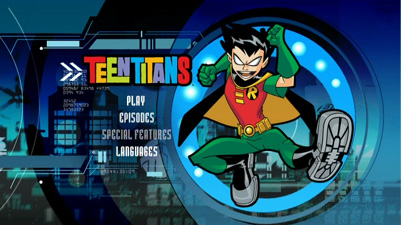
Next, there’s an interview with the lasses that sing the title tune in the Puffy Ami Yumi segment (13:15); but they cannot really offer any insight on the making of the show. This featurette includes an interview with the two young ladies, which is led mainly by Robin. I liked this segment fine, it does lack substance. It is enhanced only slightly with a Puffy AmiYumi Music Video (3:33). I like the theme, actually, and appreciate the attempt to bring back the theme song tradition. A 37-second Sneak Peek At Puffy Ami Yumi TV Show gives a glimpse at the girls’ own cartoon show.
This set does drop a couple of fairly useless games and a number of trailers from the prior DVD releases, but you are getting everything essential in this season set, plus a couple of non-essentials and some different Trailers for other DC Comics cartoons and the Teen Titans videogame.
Case Study:
Keepcase with tray and a chapter-listing insert.
Ink And Paint:
This is a near-perfect video presentation, with eye-popping colors, solid images, and no distracting compression artifacts or edge enhancement. Only the extremely rare and minor occurrence of horizontal line jaggedness during vertical pans keeps this one from perfection, but for all intents and purposes it is perfect. The episodes on this discs are uniformly bright and beautiful. Mad Mod especially impressed me, where the surreal sequence with all the moving straight black lines and circles must have been a compressionist’s nightmare. It could have been a shimmering mess, but instead it looks PERFECT. Well done!

Scratch Tracks:
There are English, French and Spanish 2.0 language tracks and subtitles. The soundtrack has some surprises in it, with pretty decent fullness and panning effects. I was not crazy about the use of so many “cartoon” sound effects in an action show, but that’s a matter of taste.
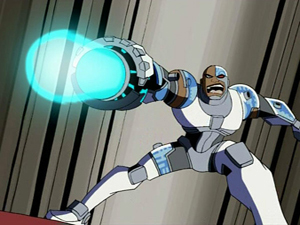
I really appreciated the musical touches brought to the show, though. The music directors use a wide variety of styles to enhance the show. Divide And Conquer has a melancholy instrumental score reminiscent of Vince Guaraldi’s work on the Peanuts specials. And I just loved the cheesy organ music that played as the theme for the corny magician villain Mumbo Jumbo in The Sum Of His Parts. Genius!! The sound design is dynamic and forceful, with some low-end rumbling thrown in for good measure. Television cartoons don’t sound much better than this.
Final Cut:
So, at first I was grumbling about how this wasn’t the Teen Titans series that I would have made (not by far)— too kid-friendly, too anime-influenced, etc. I found it an odd choice to purposefully simplify a comic primarily known for its intricate characterization. I guess I just do not see the point of such an adaptation. I was just nine years old when the comic came out, and I loved it— are kids today any dumber? It would also make more sense to give this treatment to the sillier 1960s version of the Teen Titans. And obviously, I am not appreciative of some of the anime stylings, but concede that this one especially is a matter of personal taste.
However, once I had watched the whole first season, I could better judge the show on its own merits. It still isn’t my idea of what a Teen Titans cartoon could have been, but it does have an inescapable energy that has forced me to put aside my prejudices and just enjoy the ride. While the 1980s comic it was based on emphasized relationships and the transition to adulthood, Teen Titans the cartoon show is all about action and fun. On this level, it succeeds. The animation is pretty slick, the posing is exceptionally strong, and there is a nice balance between humor and danger. There. I admit it. I’m still not big on all the exaggerated expressions and bizarre visual and sound effects, but I found them less annoying as I got into the shows. The first season episodes show off the strengths of this versatile show as it moves back and forth from comedy to suspense, with a dollop of the whimsical on the way. This is a quality show in respect to production values, animation, and moral lessons (even if overly simplistic); and the featurette on the comic and the show is surprisingly good, while the other extras hold interest as well.
I am now a fan of this show. If Justice League Unlimited is too grim for you, and old-style Super Friends is just too campy, you may find this junior superhero show fresh and entertaining.
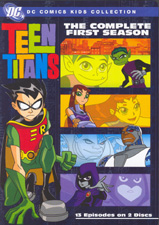 | ||
 |







